History
Our Founding
1963
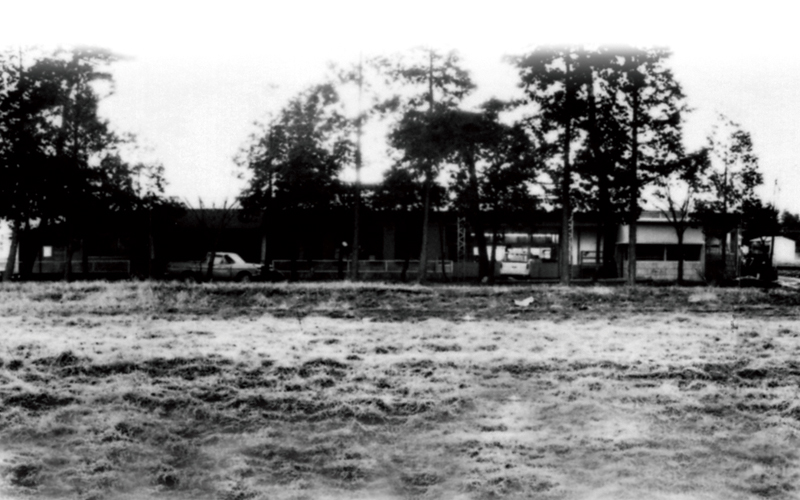
The Founding of Rheon Automatic Machinery Co., Ltd.
Our founder, Torahiko Hayashi, succeeded in developing the world’s first automatic encrusting machine in 1961. After further research, he founded Rheon Automatic Machinery Co., Ltd. in Utsunomiya, Tochigi Prefecture, in 1963, with the goal of modernizing food production worldwide using the technology he had developed. The company’s name is derived from the concept of rheology (the science of flow), upon which Hayashi based the development of the encrusting machine.
1963
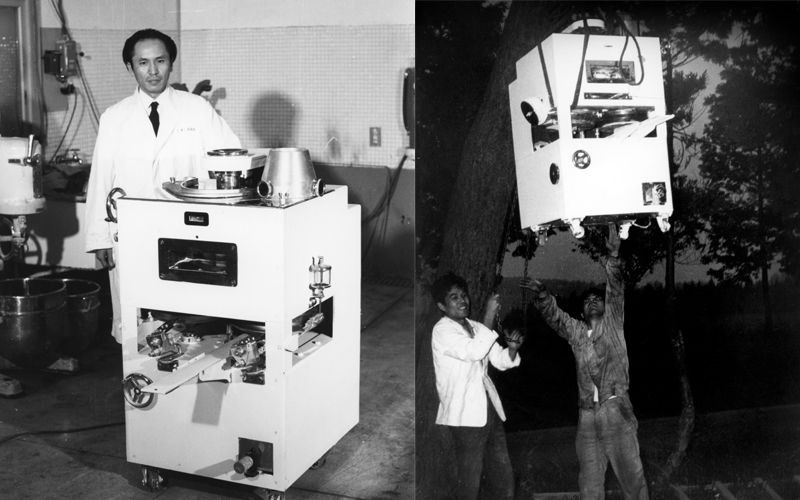
“N101” Encrusting Machine Model Launched
The N101 was introduced to the market as the first automatic encrusting machine sales model developed by Torahiko Hayashi. The mass media called it a “dream machine,” and within three months, orders for the machine reached 270 units despite only 10 units being produced per month. The story of how the initial machines would be suspended from pine trees and loaded onto trucks for shipment because there were no cranes available at the time is still told to this day.
1966
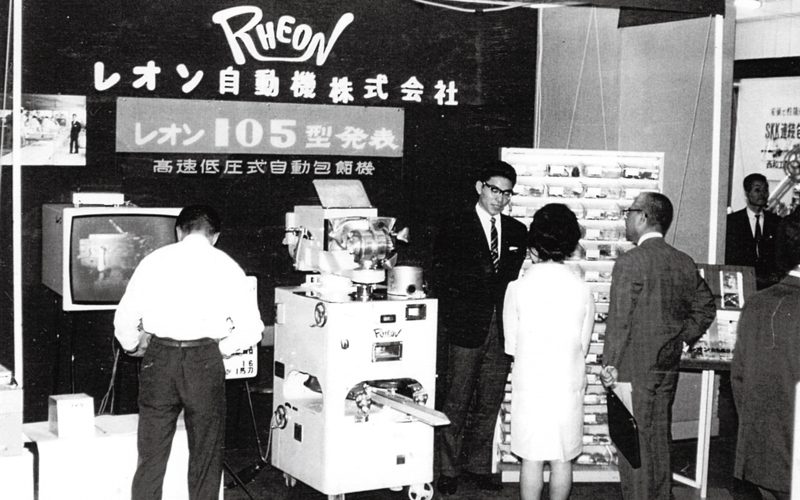
“105” Encrusting Machine Model Launched
The 105 model was launched as a general-purpose model of the encrusting machine, which had undergone continuous improvements over the years, and it became a long-seller that gained popularity among confectioners nationwide and proved indispensable to professionals for a long time. A wave of modernization was finally beginning to reach confectioners that had been forced to rely on manual labor.
1968
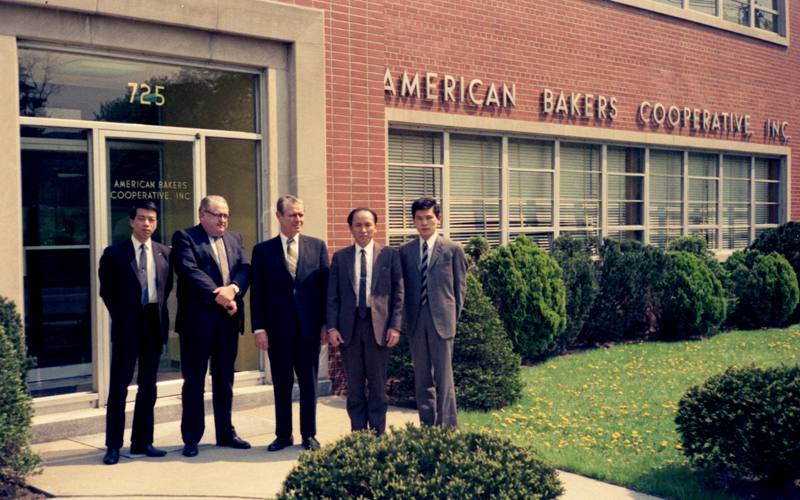
Globalization of the Market
With the “200” encrusting machine model, which expanded the machinery’s applications from the confections industry to the bread industry, the company began exporting its products overseas a mere five years after its founding. In May 1968, while visiting the U.S. for an exhibition, Torahiko Hayashi signed a long-term contract with American Bakers Cooperative, Inc. (ABC) to export 500 units per year.
1969
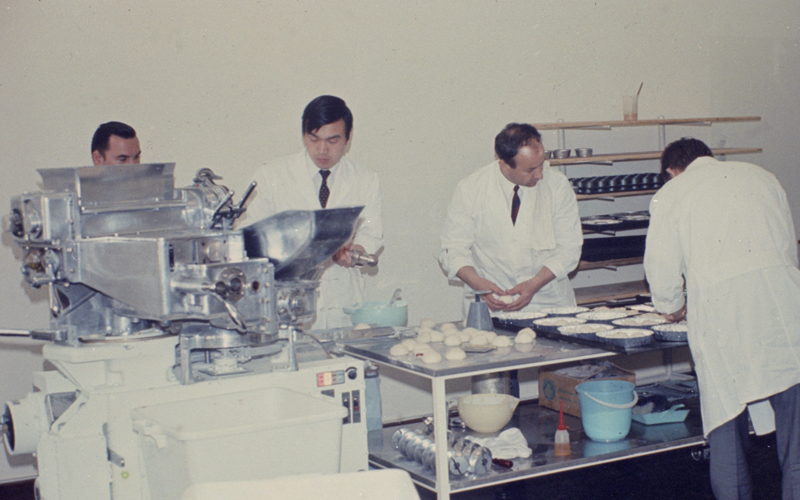
Representative Office Opened in Germany
What kind of reputation would encrusting machines gain in Germany, the industrial machinery capital of the world at the time? To assess the needs of the market, we established a liaison office and dispatched a representative. It became apparent that there was a steady need for encrusting machines, which led us to establish a sales system there and progress to the next phase.
1970
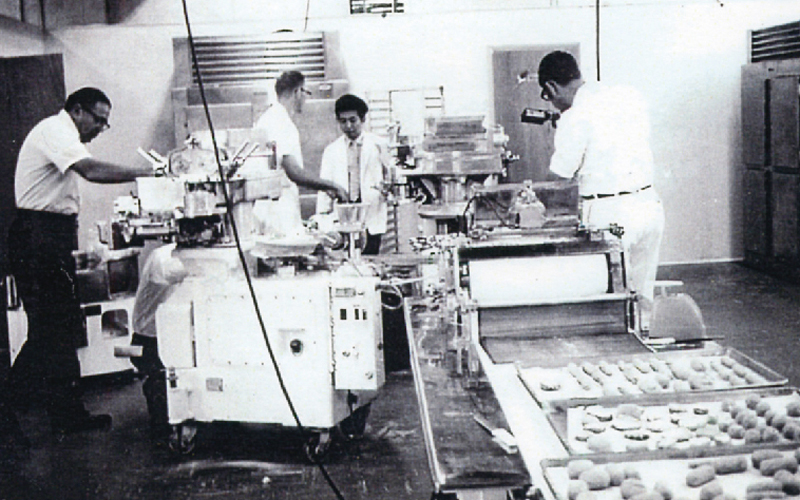
Research Institute Opened in the U.S.
We established a laboratory in Paramus, New Jersey, to provide a service base for the North American market, where sales had already begun, as well as to propel more widespread adoption of encrusting machines. At the time, most food companies in the U.S. were headquartered on the east coast, so the company decided to locate its base of operations in New Jersey to be in closer proximity to customers while conducting its activities.
Growth Period
1974
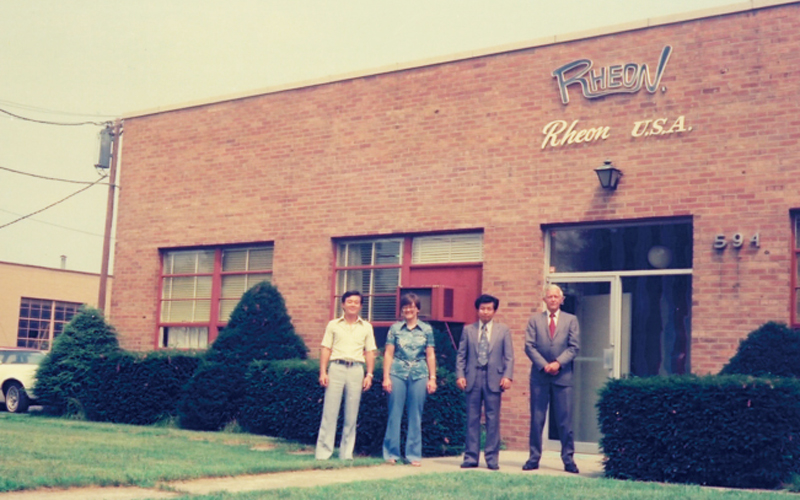
Rheon Local Subsidiaries Established in the U.S. and Germany
We opened Rheon U.S.A. in New Jersey and Rheon Automatic Machinery GmbH in Düsseldorf, Germany, thus establishing a full-scale sales and service structure across North America, South America, and Europe. These new companies would come to serve not only as sales bases, but also as experimental plants where local food companies could actually test the performance of our encrusting machine themselves.
1974
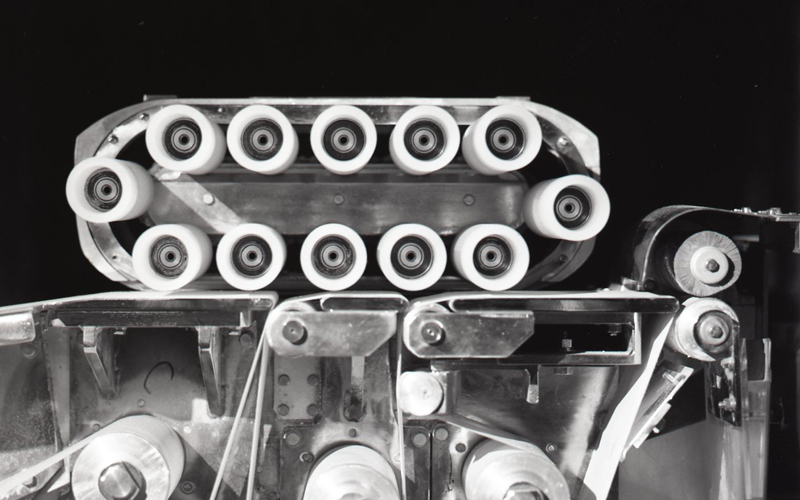
Development of the “Stress-Free Stretcher,” a Dough Spreading Device
The difficulty in making pastries lies in stretching the dough. Torahiko Hayashi took on this challenge and succeeded in developing a stretcher that could form pastries using pressure more delicate than that of the human hand. The crispy texture of a pie or Danish is created through beautifully stacked layers of dough and fat. The technology for stretching these layers of dough uniformly was an innovation comparable to our encrusting technology.
1975
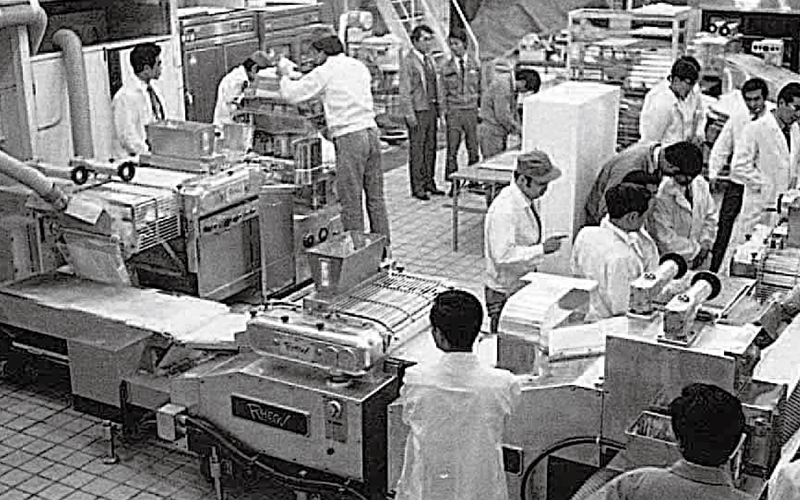
Automatic Pastry Production Line Launched
We launched the “MM Line,” an automatic pastry production line, equipped with our successfully developed Stress-Free Stretcher, a dough spreader, which attracted inquiries from manufacturers in Europe, the birthplace of pastries. Automatic production of pastries that, until then, could only be made by hand, quickly transformed pastries from a luxury item into something that could be casually enjoyed by the general public.
1979
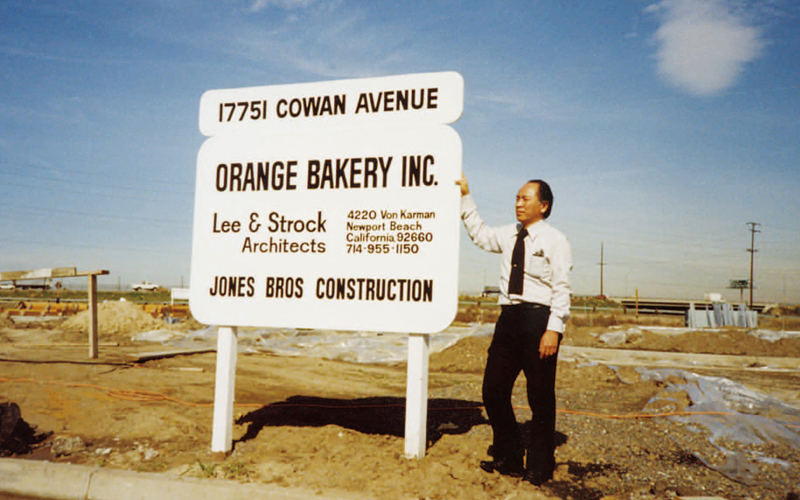
Established Orange Bakery, a Local U.S. Subsidiary
Orange Bakery began operations to serve as a model plant that offers comprehensive proposals, from production utilizing Rheon Automatic Machinery’s state-of-the-art machines to product distribution. In the 1980s, it was the mastermind behind the U.S.’s croissant boom, and its name gained recognition in the media and all around the world.
1986
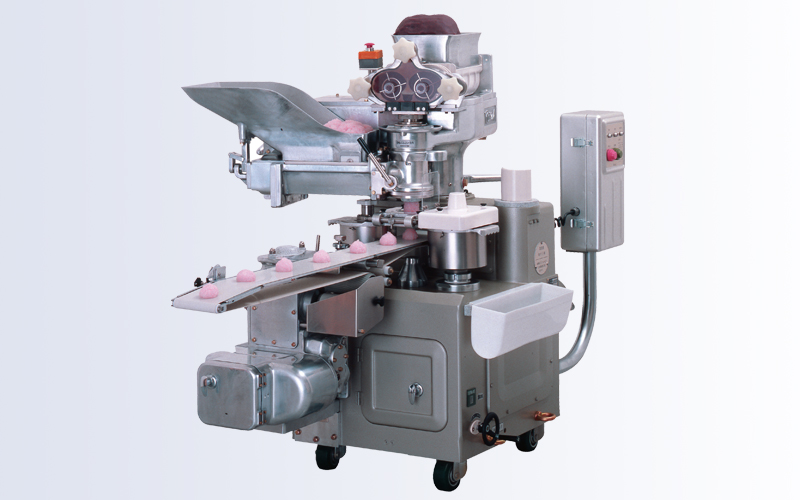
“N208” Universal Automatic Encrusting Machine Model Announced
Once it became possible to install newly developed non-adhesive encrusting machines, application of our devices expanded to include “ohagi” (bean cakes), hamburgers, and other items that are produced without using dusting, which has caused trouble for our machinery in the past. The product was a hit and became a market sensation. The N208 model, which achieved both handmade-like quality and improved productivity, was created to address the diversification of eating habits.
1986
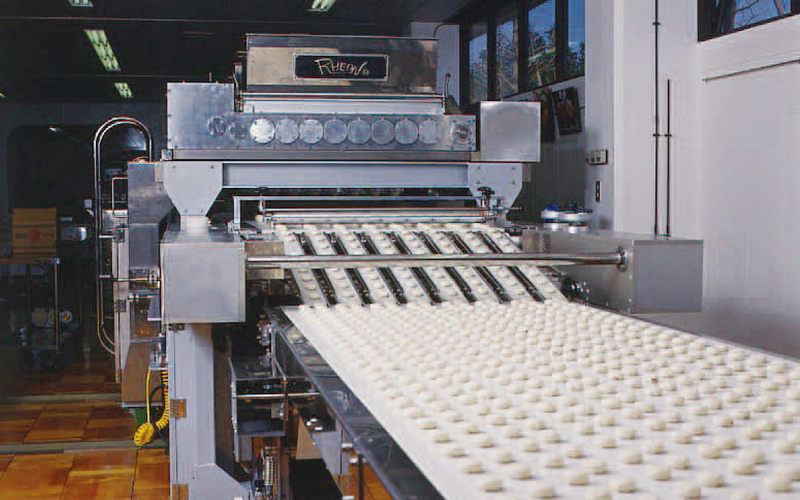
“MULTI CO-EXTRUDER” Multi-row Encrusting Machine Launched
The introduction of non-adhesive encrusting machines made multi-row encrusting mechanisms possible. Developed as the first encrusting machine model for mass-production, this eight-row machine has a production capacity of 57,600 pieces per hour. It is utilized for mass-production of cookies with fillings primarily in Europe and the U.S. and is highly regarded for its quality. In the 2000s, this model was also used in food factories in the Middle East and Africa.
Development Period
1987
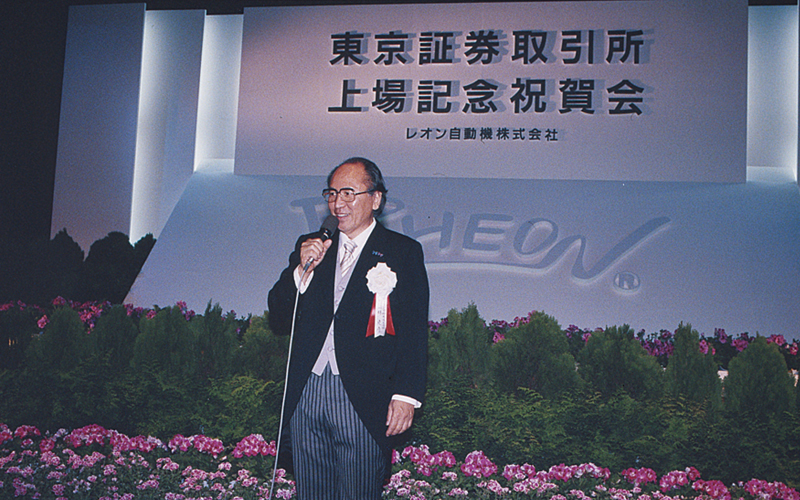
Becoming a “Public Institution”
Our company was listed on the Tokyo Stock Exchange Second Section in 1987 and the First Section in 1989, and will move up to the Prime Market in 2022. Its initial capital stock of 5.2 million yen has grown to 7,351,750,000 yen over the past 25 years. This is proof that the company has evolved into a public company not only in terms of numbers, but also by steadily developing its track record and credibility.
1987
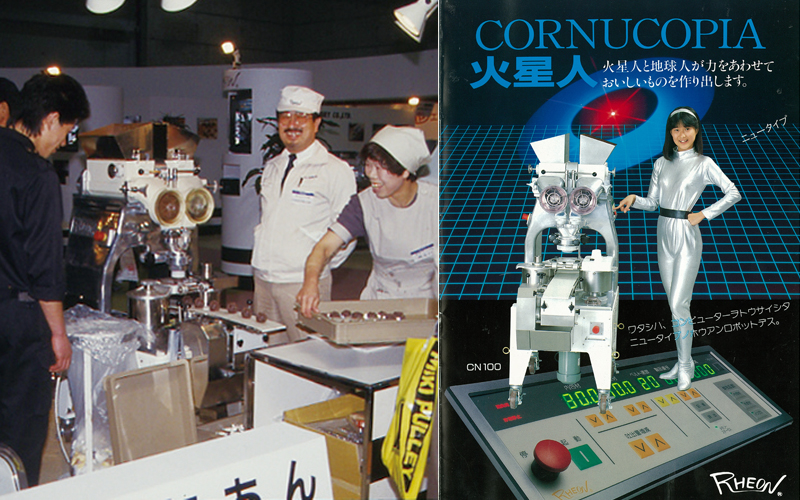
Computerized Encrusting Machine “CORNUCOPIA” Launched
CN100, the first model in the series and nicknamed “CORNUCOPIA” by the founder because of its appearance, was a completely new concept model that restricted the encrusting function to non-adhesive encrusting machines and incorporated a product memory unit (P.M.U.). The model has evolved through numerous refinements up to the present day. Among the many food forming machines developed by Rheon Automatic Machinery, this is the series that has shipped the largest number of units.
1988
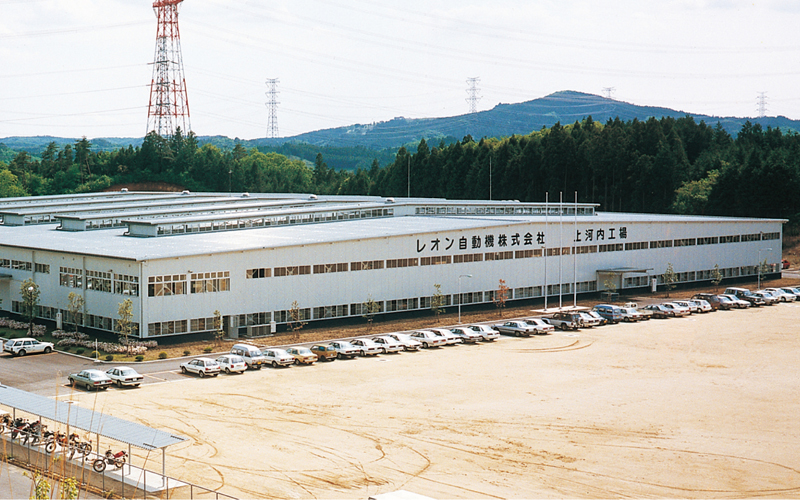
Kamikawachi Plant Production Site Begins Operations
The Kamikawachi Plant began operations as the main production plant responsible for improving quality and shortening delivery times for food machinery. Advanced machine tools have been installed, and manufacturing has become automated and non-staffed. In addition, our commitment to strict quality standards, which we have painstakingly maintained since the start, led to our acquisition of the ISO 9001 international standard for quality management systems in 2018.
1988
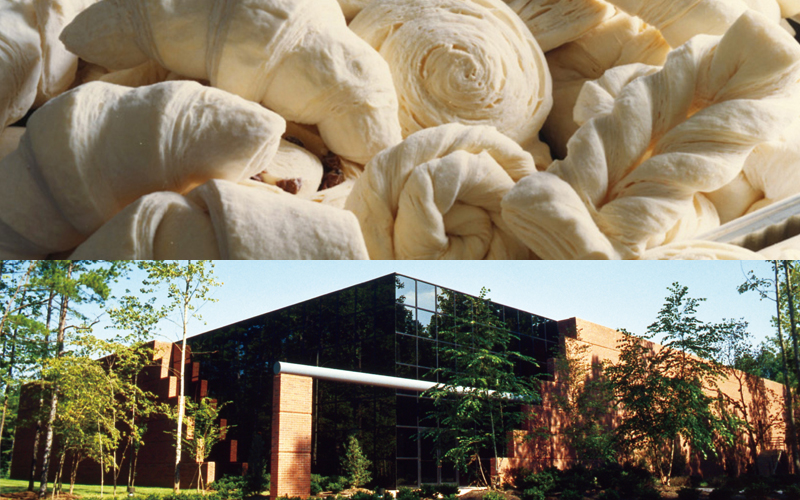
Full-scale Experimental Plant for Pre-proofed Bread Begins Operations
Orange Bakery’s third plant (the Charlotte Plant) opened in Charlotte, North Carolina. It launched full-scale research into pre-proofed bread using the best Rheon Automatic Machinery hardware and software technologies. This pre-proofing could only be achieved using Rheon’s bread-making lines, which could form the dough without damaging it and led to our forming lines attracting a lot of attention. The foundation for this groundbreaking food loss-reduction technology would later be laid here.
1994
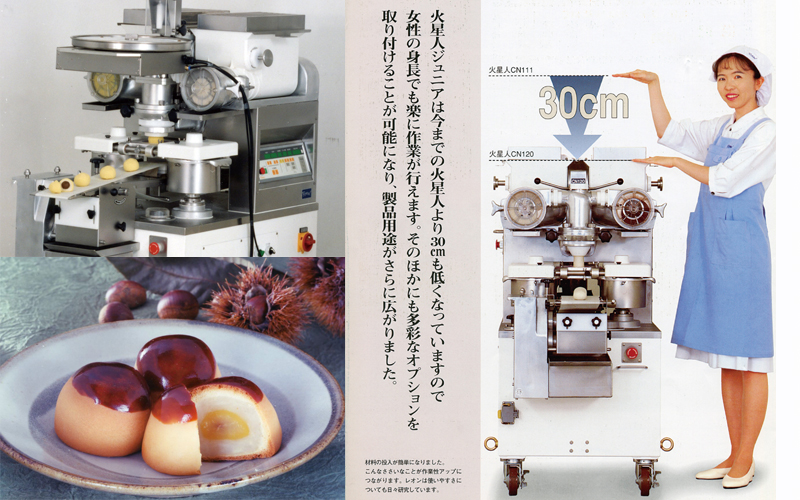
Low Floor-type CORNUCOPIA Launched
The CORNUCOPIA CN120 model was designed to be 30 cm shorter than the conventional model and was aimed at many users as a more user-friendly model. Nicknamed the “CORNUCOPIA Junior,” it has become a long-seller beloved by users nationwide for years. Also, for the first time in the CORNUCOPIA series, the device supports an optional attachment that enables automatic feeding of solid foods such as strawberries and chestnuts, making this model even more versatile.
1996
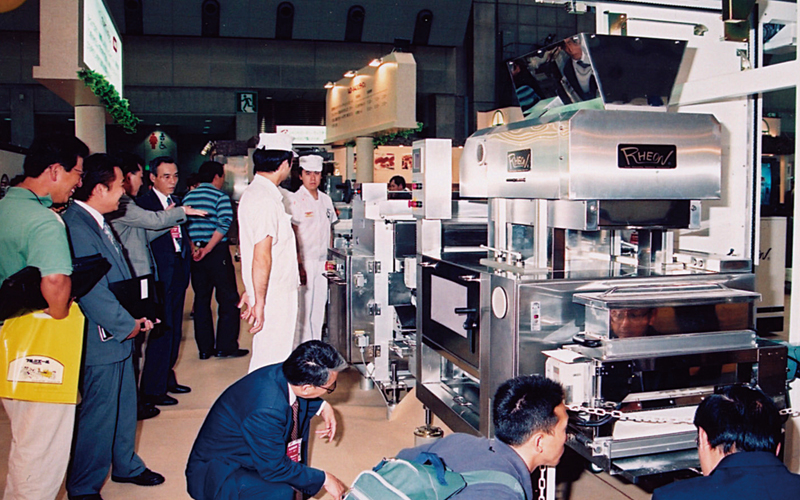
Stress Free V4 Bread Line Launched
We successfully developed the V4 Dough Feeder, which continuously discharges dough without damaging the gluten in the bread dough loaded inside. Sales were launched for the Stress Free V4 Bread Line, which features a forming line connected to a subsequent line. Achieving automatic formation of artisan breads, which in Europe and the U.S. had mostly been done by hand, gained the device recognition, and it began to be used widely around the world.
Breakthrough Period
1999
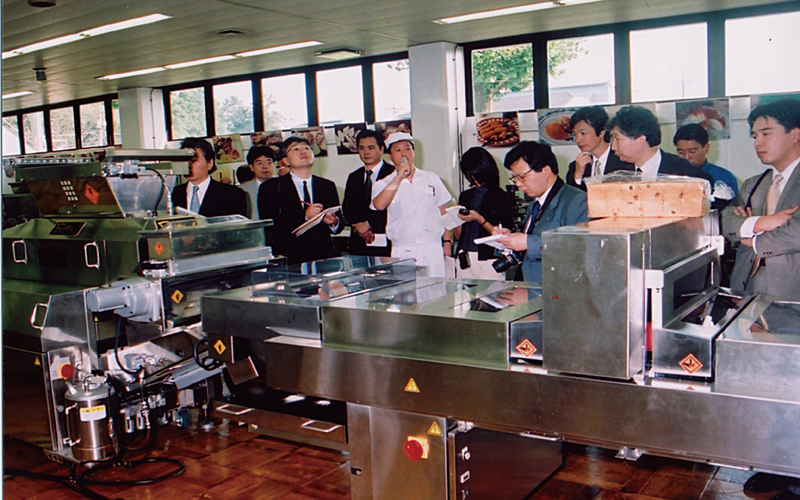
“VM System” Featuring Weighing and Dividing Functions Announced
We announced the VM System, which combines the V4 Dough Feeder with a weighing and dividing system and a dough-rolling molder. This system received a highly positive reception from the baking industry. It was praised for its ability to accommodate a variety of production methods without the need for an intermediate fermentation process, and was installed primarily by Japanese bread bakers before eventually expanding to retail bakeries and factories producing loaves for school lunches.
2000
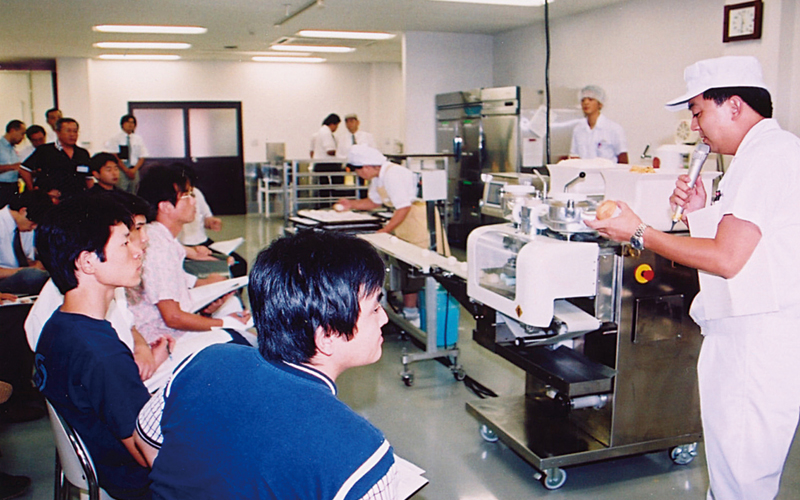
All-purpose CORNUCOPIA “CN500” Model Launched
We developed and launched the CN500, a CORNUCOPIA model with an even wider range of applications, to be useful in a variety of industries, including Japanese sweets, Western sweets, and prepared foods. This new device combined all the technologies that Rheon Automatic Machinery had cultivated to date. With its newly developed ingredient feeding mechanism and encrusting machine, this device, capable of creating a beautifully encrusted finish, allowed the CORNUCOPIA brand to achieve further penetration in a number of areas.
2011
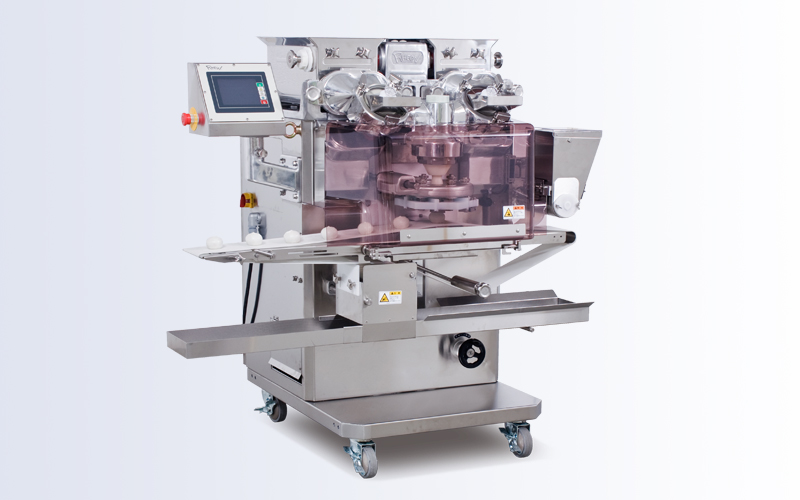
“CN580,” Refined Version of All-Purpose CORNUCOPIA, Launched
The new CORNUCOPIA model underwent further improvements that allowed for finer control over the ratios of the sent ingredients, the encrusting timing, and more in accordance with the food being produced, thus enabling higher-quality products. It was also notable for supporting the installation of a variety of optional attachments, making it possible to produce a wider variety of foods with higher added value.
2013
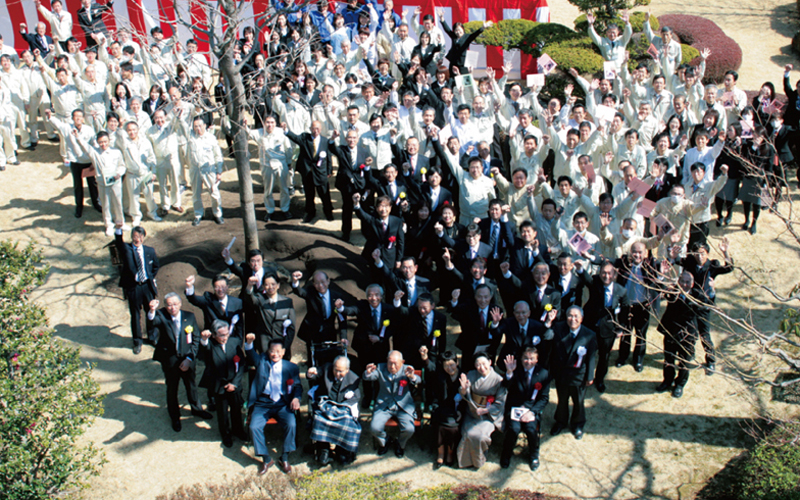
Rheon Automatic Machinery Celebrates Its 50th Anniversary
On March 15, 2013, Rheon Automatic Machinery celebrated its 50th anniversary. The company had been in business for half a century under the motto “Be a company existing.” Through its unique technology, the company has contributed to the development of the world’s food culture. With an eye toward the next 50 and even 100 years, the company took a new step forward, determined to continue its progress.
2015
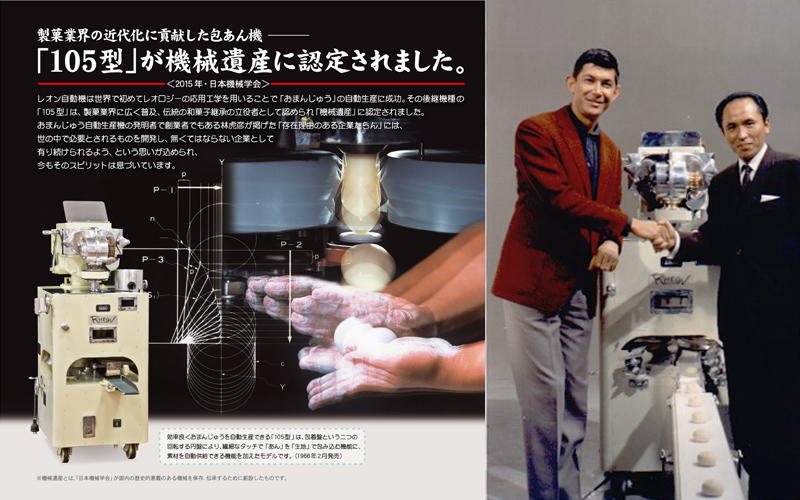
“105” Encrusting Machine Model Recognized as Part of Japan’s Mechanical Engineering Heritage
In recognition of the “105” encrusting machine model’s status as a machine technology of historical significance in Japan, The Japan Society of Mechanical Engineers (JSME) certified it as a “Mechanical Engineering Heritage” asset. The primary reason for this recognition was that 1,838 units were sold over an eight-year period, which greatly contributed to the modernization of the food industry. When it was launched, a TV commercial featuring actor E. H. Erick was released, and the model is legendary for familiarizing many people outside the industry with encrusting machines.
2019

“VM300,” an Evolution of the Bread-making VM System, Launched
The VM system boasts a maximum production capacity of 300 kg/hour. Used to produce a wide variety of breads, this system was updated with significantly improved performance and functionality, featuring a dividing weight range of 20 g to 460 g. This series is known for its highly accurate weighing and dividing system. The latest model has continued to see installations, primarily at retail bakeries.
Rapid Growth Period
2020
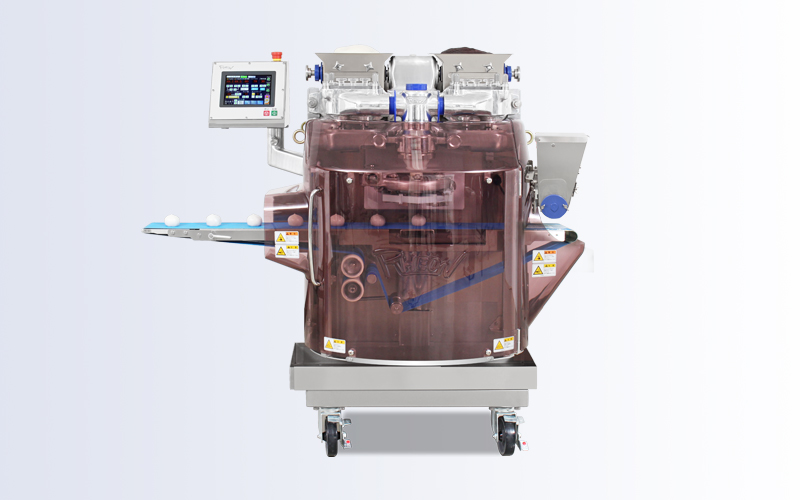
“CN700,” Our Latest CORNUCOPIA Model, Launched
The material feeding mechanism employs cycloidal feeding, which enables stable feeding of dough that has been combined with granular materials. Moreover, the two-level conveyor design achieves stable, high-speed production of 5,100 pieces an hour. In addition, the device’s easy setup function has been further enhanced to automatically adjust device movements to the appropriate settings when the weight of the food being produced is entered. The food industry has high expectations for this next-generation encrusting machine.
2020
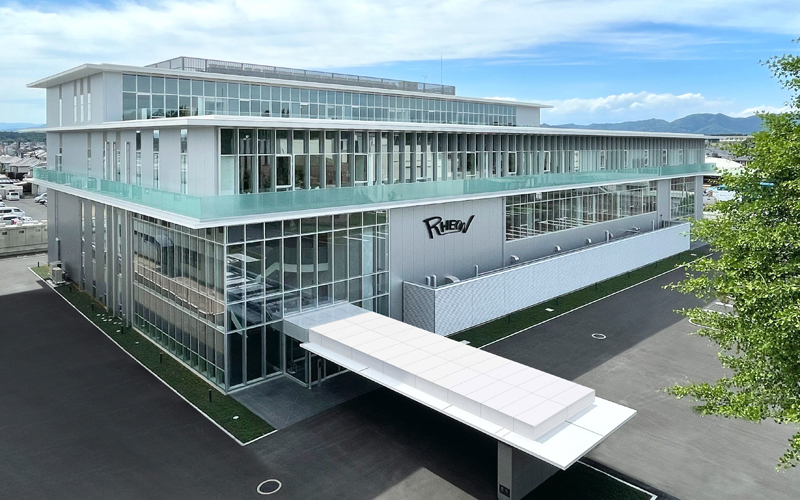
“Rheon Solution Center,” a New Company Building, Opens
To provide services that address various issues in food production, we have opened the Rheon Solution Center at the site of our head office. This center consolidates food-related information from around the world along with the latest equipment and technologies. It is a state-of-the-art facility that provides one-stop consultation services for testing the latest encrusting machine models and bread-making lines, as well as accessories and overall factory design.

